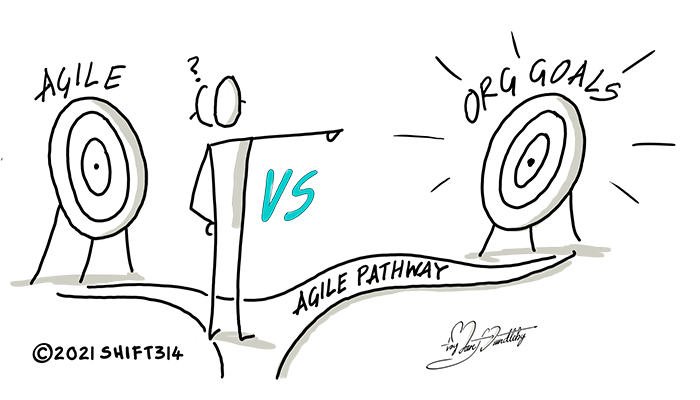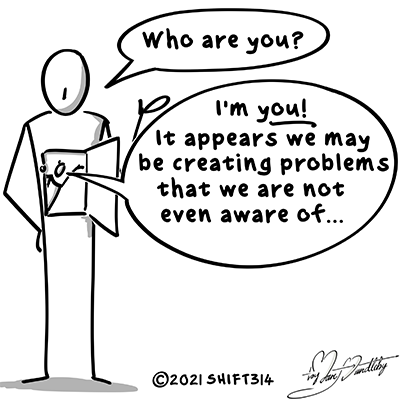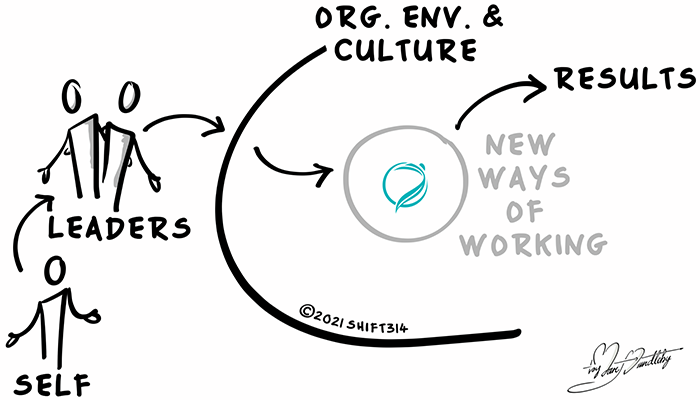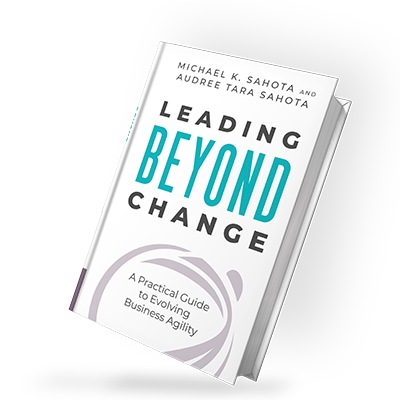Learn about purchasing for teams
The Road to Recovery: A CEC’s Journey from Agile Addict to Evolutionary Leader

My first hit of agile was in 2001 when I started using eXtreme Programming (XP)—I fell in love. My first hit of scrum was when I trained with Ken Schwaber in 2004. After that, I became a scrum addict. Later I realized kanban was agile too and it’s important to embrace a wider understanding of agility. I loved the concept of agility and its potential to light teams up—to create exciting, innovative, and amazing workplaces. I was hooked.
Ten years later, I had the biggest wakeup call of my life. I realized that even though I had been practicing as an agile coach for many years and held Scrum Alliance’s prestigious Certified Enterprise Coach (CEC) designation, I was stuck. I wasn't able to realize the full promise of agile in the organizations I was working with.
"I wasn't able to realize the full promise of agile in the organizations I was working with."
I had spent a decade at this point trying to figure out what agile really was, how to make agile work, and I couldn't figure it out. While I'd made some limited progress towards how a truly agile workplace could be realized, it wasn’t enough. I was frustrated and disappointed. I entered into a deep state of disillusionment.
Giving Up on Agile
I gave up on agile. When I realized that agile was wholly insufficient to create amazing workplaces, I took a break from the agile community. While I kept my day job working as an agile coach, I focused all of my energy on desperately learning about everything outside of agile that held the promise of creating amazing workplaces.
"I gave up on agile."
I discovered that culture, leadership and how we approach change were the missing pieces. I realized that, while high performance organizations have agility, most of them do it without using a named agile process or framework.
"Most high performance organizations don’t use "agile" explicitly"
When I delved deeply into the inner workings of high performance organizations, I realized that they had a lot in common with agile principles and practices. Not the processes or the outward structures, but the meaning behind it all.
It was later that I realized that agile is not the goal anyway. But that was just the beginning of my journey. I'll walk you through the questions I asked, and the answers I found. We'll start with the essence of agile.

The Essence of Agile
What is agile, really? Agile is defined by the Agile Manifesto.
What happens when we think of agile not as a family of processes or as an approach, but as a culture system? What we will realize is that agile is a culture fragment - a partial specification of a culture system.
We call this cultural understanding the Essence of Agile:
- Put people first
- Focus on learning and evolution
- Be flexible and adaptable to respond to change
What I realized about myself is that I was approaching agile and agility from a process perspective. And the approach I was taking wasn’t really all that agile. I was attached to specific outcomes and what we needed to achieve. I wasn’t adaptable enough to understand that organizational goals are more important than agile. I was looking at organizational change and agile externally, like it was a thing outside of me, versus something that was inside of me.
Moving Beyond Agile to Live Agile
Here's the paradox: moving beyond agile is the same as fully realizing agile. Inherent in agility is the notion of learning, adapting, and changing, where we put people first and collaborate. Agile is not about mandating. It's not about forcing our agenda because we want to be successful.
"Moving beyond agile is the same as fully realizing agile."
We are creating a new set of behaviours, a very different “way of being,” to interact with the world. When we apply this to agile principles, practices and frameworks, we are open to a broader understanding of what agile is really about.
With this shift in perspective, I understood why I couldn't get agile to work sustainably. I wasn't in a state where I could make it work. The problem wasn't agile. The problem was actually me: my worldviews, my perception, my behavior, my leadership. My inner state of consciousness was not agile; I was exhibiting behaviors and a worldview that were in a lower state of consciousness. There was little or no agile mindset within me.
"I was the problem!"
I asked myself, “Am I equipped to do this?” I realized, well, no, I'm well-intentioned, but no. The way I'm showing up, there's no way I could help any system evolve. If I'm not showing up in an evolved way, how can I help other people show up in an evolved way? Expertise in processes such as scrum, while helpful, does not win the hearts and minds of people.

My Wakeup Call
It was fine for me to teach product owners that they need to respond to change, but when changes were impacting me, I didn’t respond to change gracefully. I suddenly became aware that I had my own agenda, and that I had a really hard time surfing the waves of change.
My wakeup call showed me, very clearly, that I was the problem. I realized that if I wanted to create success, I needed to actually show up in an agile way. I had a sense that I needed to show up with an evolved mindset. “Doing” agile wasn’t helping me show up in an agile way.
"'Doing' agile wasn’t helping me show up in an agile way."
Bob Hartman coined the notion of “being” agile, but agile didn't have a defined approach or technique for “how to show up” agile. There wasn't any teaching on how to stop creating damage, how to stop my command and control behavior, and how to really “be” agile. My desire was to be successful implementing agile into organizations, yet to do this I needed to show up as a leader who can inspire and impact change. I had to “be” agile and have the agile mindset.
So, I went on a big journey of discovery to find out, what does the agile mindset really mean? And how do I become fully agile? This journey led me to an extraordinary and surprising outcome that changed everything.
An Evolutionary Journey
I wasn't “agile.” This realization began a journey to change everything about who I was and how I showed up. It began with the normal or usual suspects, attending various coaching retreats, workshops, and experiences. I became an NLP Practitioner, I did anything and everything that I thought could move the needle on how I was showing up as a human being and as a leader. I read every book I could get my hands on: books on self help, leadership, and leading organizations. I read books on what great managers do differently. I devoured Edgar Schein's epic tome on leadership and organizational change. I was a sponge, I was getting the mechanics and the intellect, but not the internal behavioral shifts needed to show up differently.
During a trip home from a client, flying across the country, I was reading Brene Brown. I had an intense moment when I read, “you can only love a person as much as you love yourself.” That hit me hard. How much do I love myself? I had a sudden awareness of how I am as a parent, a partner, a friend, a coworker, and a coach: each interaction was impacted by my (lack of) self love. I understood that I had a long way to go on my journey.
Going Deeper
I needed something more profound and much deeper. So, I began to try “weird things” that work. I started a meditation practice. This alone was not enough, but it led me on a series of wild and profound trips to India.
While I had studied brain science and behavior working on a PhD in Artificial Intelligence and have even published papers on the subject, there was nothing that prepared me for what I learned and experienced in India. I learned how our conditioning, the ego, the mind, and subconscious behaviors affect our consciousness. I experienced the impact and consequences of how lower consciousness functions. I went deep into personal growth processes and techniques to shift and to dissolve my egoic lower consciousness behavior patterns. What a surprise to discover that I have something called an ego that is sabotaging my success at every turn.
These intense experiences over many years are what changed the very fabric of my being. It changed my perceptions of the world, my relationships, behaviors and purpose. This work brought me to a humble place in my heart and gave me the desire to evolve and improve how I show up in all aspects of my life.
The passion to work on my own personal evolution allowed a shift in who I am as a person. It created an evolutionary leap into higher states of consciousness that allowed me the capability to evolve my relationships, with others and myself.
“Only a transformed person can transform the world.” - Yogananda
Transformation is a transmission that only emanates from someone who has transformed. I learned that one must go on a personal journey of self-evolution in order to have the ability to hold and support a system in its transformation.
Change Begins with Yourself
My consulting practice began to change as I began to change how I was showing up to lead. The impact was evident through my evolutionary journey. As I worked through my ego and had an evolution myself, I began to see rapid results and transformation.
There was evolution with my clients and organizations were beginning to achieve the results they were hoping for. It was no longer about agile. I was focusing on leadership and culture to support creating the desired outcomes.
Leaders would change their behavior, becoming more “agile” first, and then we would implement agile practices into the organizations. I created a model, The Evolution of High Performance, as a map to understand the journey and how to create success with new ways of working. The impact is leaders at all levels cleaning up their behavior to create an environment that supports new ways of working.

I spent many years bringing this work to the agile community through keynotes, books, webinars, meetups, and blogs, because in my heart I know that agile is part of a global shift in the consciousness of humanity.
"Agile is part of a global shift in the consciousness of humanity."
Agile has a unique role to play because it is teaching us how to work and live differently, in a more people-centric way of being. People over Process. Yet what is most important is not the processes or the structures, it's the world views - our thoughts, our belief systems, and our behaviors that will give us an “agile” organization and sustainable success.
Certified Agile Leadership with the SELF
The Scrum Alliance created the Certified Agile Leadership (CAL) program, which guides leaders to be successful with agile. In the first year (2016) of the Certified Agile Leadership courses, my company trained twenty or thirty percent of all the people who took this training worldwide. Our CAL courses emphasize leadership and culture as the way to find success with Agile, based on my personal evolution and the unique innovations in our consulting practice. What is surprising for most people is that while every CAL training program meets the same high level objectives and quality measures, each is unique.
Over the last five years, we have had a chance to refine our specific approaches not just with the clients we work with but with the hive-mind of all the leaders we train. Every training I give, I have the opportunity to re-experience the training and the learning and get insights from participants. We get to refine the models and key ideas. We have the saying at our org, “Every time we teach a CAL, we take a CAL.”
Our training evolves as I evolve. Over time it has become a very powerful, direct transmission of what it really means to create success with agile, and the inner nuts and bolts of how to do that. It's been this incredible journey of growth and evolution. I met my wife and business partner, Audree Tara, in India. Together we have co-created our leadership work that spans business and personal evolution.
For a long time, I thought the last thing the world needs is another agile framework. And yet, that’s what happened. We realized we had emergently created a very powerful body of knowledge for personal and organizational evolution: the SHIFT314 Evolutionary Leadership Framework™ (SELF): Scaling Excellence with People.
Ultimately it’s about working with our egos, so the core of it is the natural evolution from servant leadership to what we call Evolutionary Leadership. It’s the choice to evolve oneself and develop capabilities to evolve one’s organizational system. The SELF is designed to help people create environments where agile can be fully realized.
Looking Toward the Future
Agile will change how we work as well as the world beyond work. Yet, a step first is to understand the importance of creating the environment where agile will thrive. In order to get the full benefits from agile, design thinking, lean, digital, etc., we have to do the work first to create the context, culture, and environment where that kind of approach can flourish.
Agile itself points to a shift in mindset, a shift in worldview, a shift in behaviors, and a shift in our inner state as a human being. In order to move an organization from a traditional way of working to an evolutionary way of working, we need a fundamental rethink of how to approach leadership, culture, and organizational change.
We hope that you will join us as evolutionary leaders and rethink your approach to change from a new perspective with new behaviors. A new way of being enables a new way of working, shifting mindset is the key. And together we can create more than high-performing workplaces, we can create a world where people come first and the sustainable success of humanity can flourish.
Resources
If you are interested in going deeper on this topic:
- Your Agile Transformation Keys - the practical application of a cultural and mindset perspective to upgrade your Agile Transformation. Available for free on our website.
- Related Blogs: "Culture and Leadership," "Agile Is a Means, Not the Goal," "Mind the Gap: Leading with an Agile Mindset," and "High Performance Culture."
- Leading Beyond Change: A Practical Guide to Business Agility - Our new book that gives you the step by step of how to create an environment where people willingly embrace Agile.











